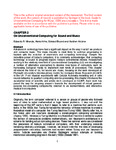On Unconventional Computing for Sound and Music
| dc.contributor.author | Miranda, Eduardo | |
| dc.contributor.author | Kirke, Alexis | |
| dc.contributor.author | Braund, Edward | |
| dc.contributor.author | Antoine, A | |
| dc.contributor.editor | Miranda E | |
| dc.date.accessioned | 2018-03-08T10:54:40Z | |
| dc.date.available | 2018-03-08T10:54:40Z | |
| dc.date.issued | 2017-12-04 | |
| dc.identifier.isbn | 9783319498805 | |
| dc.identifier.other | 2 | |
| dc.identifier.uri | http://hdl.handle.net/10026.1/11020 | |
| dc.description.abstract |
Advances in technology have had a significant impact on the way in which we produce and consume music. The music industry is most likely to continue progressing in tandem with the evolution of electronics and computing technology. Despite the incredible power of today’s computers, it is commonly acknowledged that computing technology is bound to progress beyond today’s conventional models. Researchers working in the relatively new field of Unconventional Computing (UC) are investigating a number of alternative approaches to develop new types of computers, such as harnessing biological media to implement new kinds of processors. This chapter introduces the field of UC for sound and music, focusing on the work developed at Plymouth University’s Interdisciplinary Centre for Computer Music Research (ICCMR) in the UK. From musical experiments with Cellular Automata modelling and in vitro neural networks, to quantum computing and bioprocessing, this chapter introduces the substantial body of scientific and artistic work developed at ICCMR. Such work has paved the way for ongoing research towards the development of robust general-purpose bioprocessing components, referred to as biomemristors, and interactive musical biocomputers. | |
| dc.format.extent | 23-61 | |
| dc.language.iso | en | |
| dc.publisher | Springer International Publishing | |
| dc.relation.ispartof | Guide to Unconventional Computing for Music | |
| dc.subject | Biocomputing | |
| dc.subject | Unconventional Computing | |
| dc.subject | Computer Music | |
| dc.title | On Unconventional Computing for Sound and Music | |
| dc.type | chapter | |
| plymouth.publisher-url | http://www.springer.com/gb/book/9783319498805 | |
| plymouth.publication-status | Published | |
| dc.identifier.doi | 10.1007/978-3-319-49881-2_2 | |
| plymouth.organisational-group | /Plymouth | |
| plymouth.organisational-group | /Plymouth/Faculty of Arts, Humanities and Business | |
| plymouth.organisational-group | /Plymouth/Faculty of Arts, Humanities and Business/School of Society and Culture | |
| plymouth.organisational-group | /Plymouth/REF 2021 Researchers by UoA | |
| plymouth.organisational-group | /Plymouth/REF 2021 Researchers by UoA/UoA33 Music, Drama, Dance, Performing Arts, Film and Screen Studies | |
| plymouth.organisational-group | /Plymouth/Users by role | |
| plymouth.organisational-group | /Plymouth/Users by role/Academics | |
| dc.rights.embargoperiod | Not known | |
| rioxxterms.versionofrecord | 10.1007/978-3-319-49881-2_2 | |
| rioxxterms.licenseref.uri | http://www.rioxx.net/licenses/all-rights-reserved | |
| rioxxterms.type | Book chapter |


